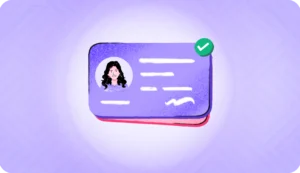The math is simple. Onboarding more customers equals more revenue. But what if the customer turns out to be an imposter? Your business could be in serious financial and legal trouble.
Digital ID verification is vital in cases like these. It ensures that businesses, such as banks, verify customers with precision. For instance, one must pass ID verification before opening a new account. This is also a strong form of fraud and identity theft prevention
With digital ID verification, businesses limit crimes like identity theft and money laundering. In cases of money laundering, digital ID helps trace suspicious transactions. This makes the prevention of fraudulent activities much easier. Thus, implementing customer verification protects the entire financial system. It also maintains the system’s integrity.
What is customer identity verification?
Customer verification refers to the process of validating a customer’s identification. It can take many forms, such as email verification, address verification, and phone verification, but it always entails establishing that a person is who they claim to be. It ensures the security and integrity of financial platforms and marketplaces. Tasks such as opening a bank account confirm a person’s identity. They also include handling financial transactions. Strong identity verification prevents fraud and illegal activities while adhering to the law.
Why is the customer verification process essential?
Customer identity verification can save your business by:
- Fraud prevention: Ensuring your customer’s identity can help you avoid or limit fraudulent activities.
- Protecting reputation: Certain frauds, such as identity fraud, can damage your reputation and customer trust.
- Complying with regulations: Many industries have legislation requiring companies to verify their customers’ identities. For example, banks must follow Know Your Customer (KYC) rules. They also follow Anti-Money Laundering (AML) regulations.
- Improving customer experience: Verifying customers can avoid a large volume of delays. It ensures a smooth and seamless journey for the customers.
How does the customer identity verification process work?
In a digital world, customer identity verification is crucial for preventing fraudulent activities and ensuring legal compliance. Here’s what constitutes the entire process of identity verification.
Collecting customer information
Collecting Personally Identifiable Information (PII) data is crucial. It verifies your customer’s identity. For example, their name, date of birth, and government-issued ID, such as AADHAR, PAN Card, etc.
Verifying provided information
After collecting data, systems use many methods to verify its accuracy. Cross-checking it against databases and public records is the first step. Customers need to answer certain security questions. It can also include comparing ID photos to the live image, or checking their contact details.
Risk assessment
After confirming a user’s identity, the next step is a risk assessment. The firm checks whether the customer poses any risk. They need the customer’s location, transaction history, and other private details. Any potential red flag is also considered. This may include checking for fraud, sanctions lists, or Politically Exposed Persons (PEPs).
Decision-making
The final step is decision-making. The firm chooses whether to approve, refuse, or escalate the customer verification process. All past verification methods inform this decision. It also considers any known risk factors.
Methods of customer identity verification
Several methods verify consumer identity. They have different levels of effectiveness and security. These verification techniques include:
Multi-factor authentication
To enhance security, users provide many forms of identification. These include passwords, security questions, and biometrics. Furthermore, the system sends a one-time password to their phone or email. Two-factor authentication (2FA) is a popular method of this type.
Document verification
This involves checking the authenticity of official identity documents. The customer provides these identification documents, such as government-issued IDs or passports. This form of customer verification is either manual or automated.
Age verification
Age verification ensures that the customer meets the age limit. It is for certain products or services. ID scanning, asking for a date of birth or other methods can verify age.
To understand more about age verification, learn more about age gating and age verification.
Video verification
This customer verification method involves a video call to verify the individual. It is akin to facial recognition or photo verification.
Biometric authentication
This checks a person’s unique physical characteristics. It uses things like fingerprints, voice, or face to confirm a person’s identity. This method’s popularity is rising due to its accuracy and convenience.
Watchlist screening
Watchlist screening involves checking the customer against various watchlists. For example, sanctions lists or fraud databases. This helps identify any potential risks or red flags associated with their identity.
Knowledge-based authentication (KBA)
This requires prompting customers to respond to specific personal questions. They usually request data like credit history or personal details only they know. Used with other methods, this serves as an added level of authentication.
Legal and regulatory requirements
Many businesses need customer identity verification due to legal or regulatory requirements. Here are some instances:
- Global and regional regulations
Business operations must follow global and regional rules around identity verification. Some examples include:
- Recommendations from the Financial Action Task Force (FATF) in Europe
- EU’s Anti-Money Laundering Directives (AMLD)
- USA Patriot Act
Regulations differ based on geographies and you need to ensure that your identification process is compliant with the required regulations.
- KYC and AML
Businesses in the financial sector must follow AMLD in Europe or KYC requirements by the Financial Crimes Enforcement Network (FInCEN) in the US. Compliance is essential to prevent accidental money laundering or terrorism financing.
- Data protection and privacy laws
Adhering to data protection and privacy regulations, such as the General Data Protection Regulation (GDPR), is vital. Businesses must handle sensitive data with security measures in place. They should only collect data with explicit consent from customers.
- Sector-specific regulations
Certain industries have more regulations to ensure compliance. The US healthcare sector is a notable example of this. It has rules, such as the Health Insurance Portability and Accountability Act (HIPAA).
How to improve your customer identity verification process?
Customer verification creates a safe online environment. Organizations can create simple and robust processes for implementing customer identity verification. Let’s look at some key tips for improving your customer identity verification processes.
Adopt a risk-based approach
Besides customer verification, firms should conduct risk monitoring and business verification. This rules out their involvement in illegal or high-risk activities. Besides, this also reduces potential hazards for both the company and its clients.
Leverage technology
Document verification services use advanced technology. They use it to check ID documents such as passports and driver’s licenses. These services can confirm the authenticity of the documents with swift accuracy. Adding these services to your identity verification process adds another layer of scrutiny. This improves security.
Artificial intelligence (AI) and machine learning
Using AI-powered technology can significantly improve fraud detection skills. Algorithms can recognize patterns and anomalies in user behavior. This technology makes the customer verification process more accurate and efficient. They refine their approach through ongoing study and adjustments.
Continuously track and update
Cyber dangers are constantly evolving, as should your security processes. To stay ahead of hazards, regularly update and improve your security measures. This includes updating software, encryption mechanisms, and authentication processes. You need regular security audits and vulnerability assessments. They are crucial for identifying and fixing flaws in your system.
Provide a seamless customer experience.
Security is essential, and a smooth, intuitive experience is equally important. Complicated customer verification methods might cause client dissatisfaction and abandonment. Reducing forms can make identity verification quite seamless and easy. Striking the right balance between security and ease of user experience is key. It is critical to success.
Educate customers on security measures
Open and honest communication with customers is crucial. Inform them about the security measures in place for customer identification verification. Explain the need for strong, unique passwords. Describe how multi-factor authentication adds to security. Customers are more likely to trust your platform with their sensitive information.
How AI can improve customer identity verification
More than 85% of customers want to experience proactive communication and contact from a business. But many companies only review about 2% of customer interactions. This is due to the time-consuming and manual nature of analyzing conversations. This, in turn, makes it difficult to follow the customer verification protocols. AI solutions can address these challenges.
- Ensuring regulatory compliance.
Compliance is an unavoidable need in the complex web of financial regulations. AI in KYC automation enables firms to meet regulatory standards without interruption. Users can adjust automated systems in real time to adhere to new laws. This ensures that firms stay on the right side of the law.
- AI systems can react to changing laws in real time.
This is a significant benefit for organizations. They do not have to redo processes with each rule change. They refresh AI-driven KYC systems with rapid flexibility. Thus, they follow the rules without disrupting daily work.
- Mitigating fraud and financial crimes.
AI’s power stems from its capacity to process information with utmost accuracy. Machine learning models can identify anomalies. They can alert firms to potential hazards and prevent fraud. This protects financial institutions, while also instilling trust in clients.
- Enhancing customer trust and experience.
AI technology with human skills results in a remarkable synergy. Human oversight ensures that the AI system remains ethical and accurate. It addresses any anomalies or issues that may arise in identity verification processes.
- Streamlining onboarding and verification processes.
AI-based identity verification can simplify client onboarding. Traditional approaches often require customers to provide several documents. This caused delays and significant frustration. AI reduces the time for businesses to verify customer identities and open accounts. This gives customers a seamless experience.
Conclusion
With the development of digital transactions and remote contacts, customer verification is crucial. Especially in ensuring corporate trust and security. As technology advances, businesses must stay up to date. They must update their verification process. Evolving client needs and security risks demand comprehensive solutions.
It’s time to upgrade your customer identification verification procedure using HyperVerge. Our AI system is designed to streamline digital identity. It also improves customer verification processes. HyperVerge One provides a unified user experience, minimizing the risk of fraud.
Is your organization ready for the future of client identity verification? Sign up with HyperVerge today! A streamlined, secure, and intelligent online identity verification procedure awaits you.
Frequently asked questions
Why is customer identity verification important for businesses?
We need to verify customer identification. It stops fraud, instills trust, and improves security. This process also fosters a sense of security and confidence among customers. Moreover, it plays a key role in optimizing operational processes and creating a more seamless experience for customers.
How can businesses ensure the security and privacy of customer data?
To keep customer data secure and private:
- Businesses should use strong encryption.
- They should also follow data protection rules and use secure data channels.
- They should train their employees on best practices for data protection.
What are the challenges businesses face in implementing customer identity verification systems?
Businesses must navigate a complex web of technology and regulatory changes. Other challenges include:
- Developing strategies for fraud prevention.
- Handling data security issues
- Navigating changing customer expectations.
To do these with precision, they need to invest in the right technology. They also need to understand the legal and social aspects of ID verification.





